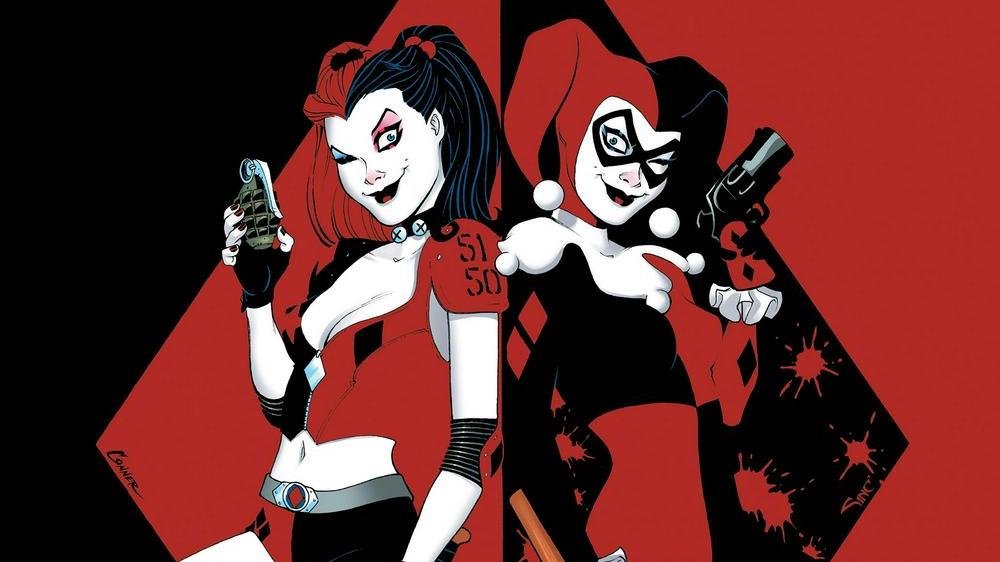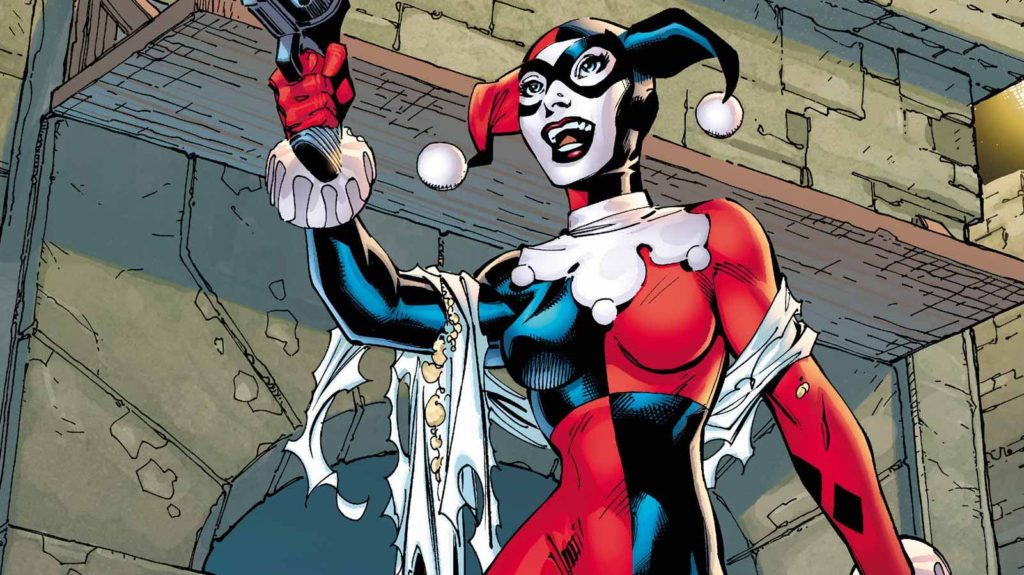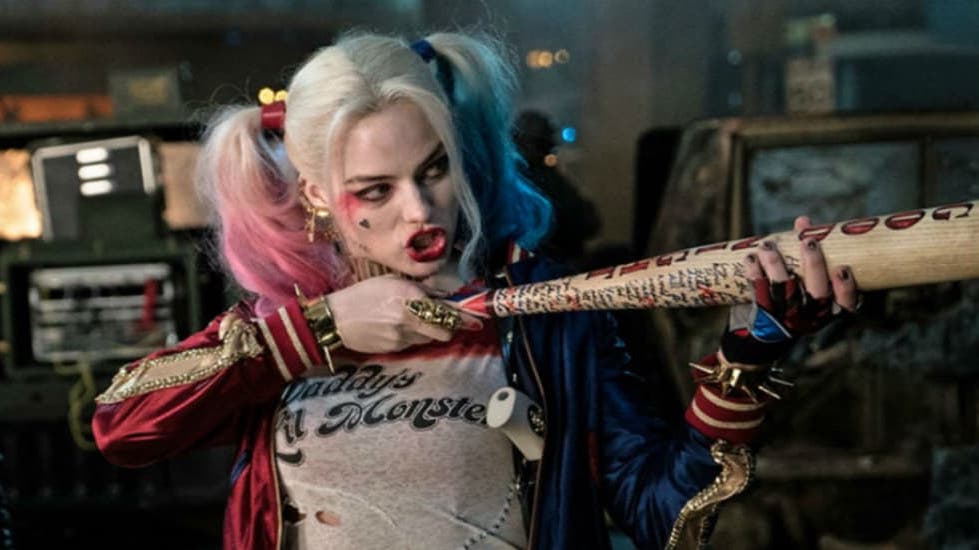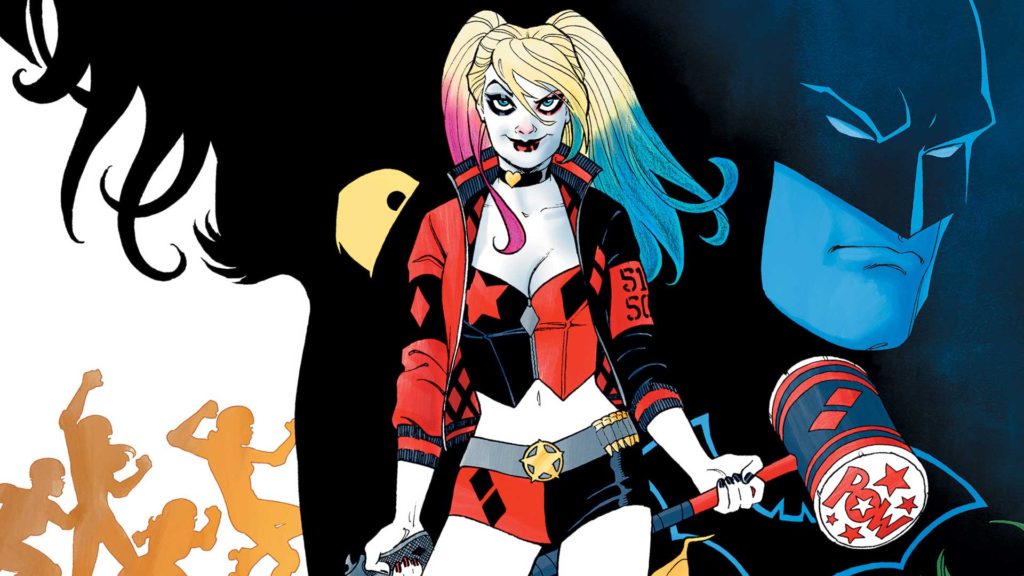History of: How The Harley Quinn Cartoon Character Became So Popular

Join the community on Reddit for the latest Marvel & DC news!
In the world of comics, very few characters can boast the history that Harley Quinn and Harley Quinn comics can. She’s the on and off again sidekick/girlfriend to arguably the greatest villain in DC, The Joker, the occasional love interest of Poison Ivy, a valuable (?) member of the Suicide Squad, and often the thorn in Batman’s side.
One of the most remarkable things about Harley Quinn is that, unlike most popular heroes and villains who’ve been around forever, she has only been around for 27 years. Even more remarkable is that she didn’t make her first appearance inside the pages of a comic. Harley actually made her first appearance in an episode of Batman The Animated Series back in 1992.
But I’m sure that you knew that.
I wonder, however, if you’ve ever thought as to why and how she become so popular, so quickly.
Think about it.
Most comic book characters who have had any degree of mainstream success (outside of those that have been in a recent movie) weren’t created a couple of decades ago. Instead, they were created over half a century ago.
- Batman
- Superman
- Captain America
- Spider-Man
- Wonder Woman
But for reasons that I’ll get into, the Harley Quinn cartoon and subsequent comics became popular without having to have been around for half a century. Not only has she become incredibly popular, but she has also become a trailblazer for all characters created after her.
- Wiccan
- Jamie Reyes Blue Beetle
- Kate Bishop
- X-23
Harley proves that a character doesn’t need history as long as a lifetime to gain any sort of popularity. She proves that the right creator, the right idea, and the right illustrator can do just about anything.
But before we elaborate on that…
Growing up and excelling in gymnastics, Harleen Quinzell was given a scholarship to attend Gotham University. Rather than pursue gymnastics, she decided to pursue psychology. After it’s completion, her degree enabled her to land a job at the not so coveted Arkham Asylum. When asked why she wanted to work at Arkham, she simply stated that she wished to work on high-profile cases and where better to do this than at Arkham?
Her desire for a high-profile case was granted when she was assigned the highest profile of them all, the Joker. It immediately became apparent that he was more than just a high-profile case to Harleen. In fact, the more she was around him, the more she wanted to be around him.
One night after returning to her desk, she found a single rose with a handwritten letter attached to it. The letter made a simple request to her… “Come down and see me some time.”
And who was the letter from?
The sender was identified simply as “J”.
Out of curiosity she traveled to the Joker’s cell and questioned how he was able to escape it. Rather than answering, he told her how much he liked her name. He then pointed out how easy it was to change her name from Harleen Quinzell to the classic clown character, Harley Quinn. As she walked out, he told her that it was she who brought a smile to his face and that he wished to confide some secrets in her. Intrigued by his wish, she petitioned Arkham for months to allow her to interview him. Eventually, she got her
As a side note, one of the basic understandings about the Joker is that is past isn’t understood. Instead, it’s filled with lies and deceit that are so entangled that even he doesn’t know the truth about it.
Anyway…
His story told of the one and only time he saw his father smile. He told her that after seeing the smile, his only wish in life was to see his father smile and laugh again.
Their sessions continued for weeks. As they continued, Harley realized that the Joker was not a psychotic killer but instead, a misunderstood person. She saw him as a troubled boy who only wanted to bring his father joy. He even convinced her that Batman was the villain and not him. He did this by explaining to her that Batman constantly foiled his attempts at laughter. Over time, the two became so close that on occasion, it was he that was interviewing her.
One day the Joker escaped only to be beaten up and brought back to Arkham by Batman. Horrified by what she was seeing, she rushed over to the side of the Joker. Later that night, she ran out, got a costume, some bombs and made her way back to Arkham. After the dust settled and the cell blown wide open, the Joker was free and Harleen Quinzell had become Harley Quinn.
But that’s only half the story.
Most think that Paul Dini created Harley. While this is mostly true, it isn’t completely true.
The original Harley Quinn cartoon was voiced by Arleen Snorkin. Although that name may not strike a chord with you, it’s one that you should remember.

Before she voiced the Harley Quinn cartoon, Arleen
And what was the suggestion?
She suggested the show incorporate a daydream sequence that saw her act as a court jester. The executives liked it and a little while later, Arleen was seen on screen wearing a jester’s outfit, roller skates and telling jokes.
As luck would have it, Paul Dini and Arleen Snorkin were old college friends. One day she gave him a tape of her favorite moments from her time of Day of Our Lives. On that tape, of course, was the jester moment.
During this time, Dini was an unknown writer who had sent in scripts for the not-yet-aired Batman The Animated Series. He had been struggling to come up with a female character to use in the series. Until the tape, Dini had toyed with the idea of a henchman or a street thug. After seeing his friend as a jester, he came up with the idea of Harley Quinn.
After showing the Harley Quinn cartoon character to lead artist, Bruce Timm, Timm fell in love with the idea and began making artistic changes to Harley. With the character fleshed out, Dini asked Snorkin to come in and read some lines for her co-creation. Not completely prepared for it, Snorkin supplied the voice that came most eas
After she debuted, DC and Warner Bros. knew that they had a hit on their hands.
So, to capitalize on what was happening, Dini and Snorkin got to work on bringing her back. Even though they had a hit, nobody could’ve known that one of the most revolutionary characters in comics had just been created.
So, back to the original question. Why did the Harley Quinn cartoon become so popular?
Simple.
For as insane as she may be, Harley Quinn provides something that very few characters can provide. Relatability to a younger audience. In his era, Spider-Man became popular because he was a teenager with teenage problems. Captain America became popular because he personified the ideals of the time period he was born in. And Superman became popular because he could do things that other characters couldn’t.
The Harley Quinn cartoon and following comic books became popular and remain there because she identifies with the audience that reads her. Harley Quinn is a Millennial. She’s not of the wartime era. She’s not of the flower child era. And she’s not of the gritty era. Instead, she’s from an era that advocates for personal well-being. She’s a woman who stands up for herself, isn’t afraid of tough situations, speaks her mind, will “drop the gloves” if the situation dictates it, and lives life by her standards.
This era, the one that we now live in, practices exactly all of these.
What’s amazing about Harley is that those who don’t read her, know exactly who she is. Harley, more than most other characters, has appeared all over the world in mediums outside of comic books.
Aside from the aforementioned Batman The Animated Series, Harley Quinn was featured in a prominent role in 2009
As good as the game was, however, it didn’t come without controversy. This version of Harley Quinn ditched everything that the world knew about her look. In its place was a character whose only resemblance to Harley was her actions and voice. Her costume changed from a jester-type appearance to a look akin to a midnight girl trying to get some work. The new-look came with very mixed reviews. Purest wanted the old Harley, their Harley, back. In contrast, those seeing her for the first time, couldn’t get enough of her. If this doesn’t make sense, remember, the number of people seeing her for the first time outnumbered those who knew her. Whereas good comics, Harley Quinn comics included, rarely hit the 100,000 issues sold a month target, Arkham Asylum sold well over 2 million copies.

The more I think about it, the more I agree with her costume change. There has always been a sexual side to the character. Whether it’s been the sexual innuendos dropped in the Animated Series, the way she dresses or the way she describes Poison Ivy or the Joker, Harley has always been a symbol of sex.
Speaking of Suicide Squad…
Although Suicide Squad was, for lack of a better description, an uneven junk pile, Harley Quinn still managed to shine. She was the reason that people watched it more than once and she’s the reason that its spin-off follows her exploits. Harley Quinn didn’t, however, only shine in the movie. She shined as she’s always shined…all the way to the bank.
Like so many times before, toys and dolls were made, Harley Quinn comics were written, spin-off movies were planned, and more. Even replica’s of her half-naked costume from Suicide Squad were available for purchase. Since her creation, both DC and Warner Bros. have ridden her success all the way to the bank.
In saying all the above, anyone who knows the character knows that she’s more than just a sex symbol.
Over the course of her history, Harley has transformed into a rallying point for those in tougher than normal relationships.
A little while back I referenced Harley Quinn in an article I wrote about Poison Ivy. Without rehashing word for word what I wrote, I said that Harley had spent the better part of her existence in an abusive relationship. She had been abused verbally, emotionally, and physically by the hand and mouth of the Joker. And it wasn’t him who offered her help. It was Poison Ivy.
I’ll backtrack to Batman The Animated Series. There’s an episode in the series that shows exactly this.
The episode begins with the Joker verbally and emotionally abusing Harley. He asks her if and when she has ever had a worthwhile idea. This circumstance is but one of many we’ve watched play out time and again in comics. The Joker beats down Harley and because she’s submissive to him, she always returns to his side. This form of relationship is one that far too many people in the world are familiar with.
As the episode progresses, Harley’s character grows.
Seeing what was happening, Poison Ivy comes to her aid and immediately begins to issue her “some lessons in good old female self
At her core, the Harley Quinn cartoon character shows and teaches those in difficult situations that it isn’t impossible to get out of them. She teaches that nobody, no matter where they came from, should be subjected to any sort of violence. And she teaches that help is only ever an ask away. There are literally thousands upon thousands of thank you notes, essays, and letters in existence thanking Harley and those responsible for her creation. The notes all say the same thing…it was Harley who got me through the tough times.
You may ask yourself, what about Wonder Woman? Surely DC’s all-time most popular woman has received praise like this? To that, I answer, probably. But not in the same way that Harley has. Wonder Woman is the personification of perfection. She is without flaw, morally straight, and lives by a code of honor. I can’t speak for you but I don’t know too many people who live their lives like that. Most people that I know of
If Harley were to have gained popularity based on her relatability alone, it troubles me to say it but I don’t think that would’ve been enough. Don’t get me wrong, relatability is crucial for characters of any kind to get off of the ground. I just don’t think it’s enough. The audience, no matter who they are, has to be entertained by what they see.
Harley is entertaining.

Over the years, and with the help of many others, Harley has made a 90
I digress.
Think Deadpool.
Just as Deadpool was for Marvel, the Harley Quinn cartoon character and following comic books were a breath of fresh air for DC. Both Harley and Deadpool walk the line between heroism and villainy. Each is a sociopath that is unafraid to say exactly what they are thinking. They both use humor as an outlet. And each is overtly violent. In truth, outside of their powers, they really only differ in one aspect. Deadpool knows he’s a comic book character and addresses his readers, whereas Harley, for a long time, didn’t. But even that’s changing. As her popularity soars, so too does the way in which she interacts with her readers. Like Deadpool, she’s begun breaking the Fourth Wall.
Harley is one of the main reasons that DC has continued to be one of the two biggest publishers on the planet. Even the legendary Jim Lee has referred to her as DC’s fourth pillar…Batman, Superman, and Wonder Woman, of course, being the other three.
She came onto the scene and continues to grow in an untraditional way. She’s relatable, entertaining, smart, of the new age, and most importantly, she shows that there is light at the end of a very tough tunnel.
As I always do with these in
So, may they be around forever.
Cheers,
Joel
Liked this article? Join the community on Reddit for the latest Marvel & DC news!

